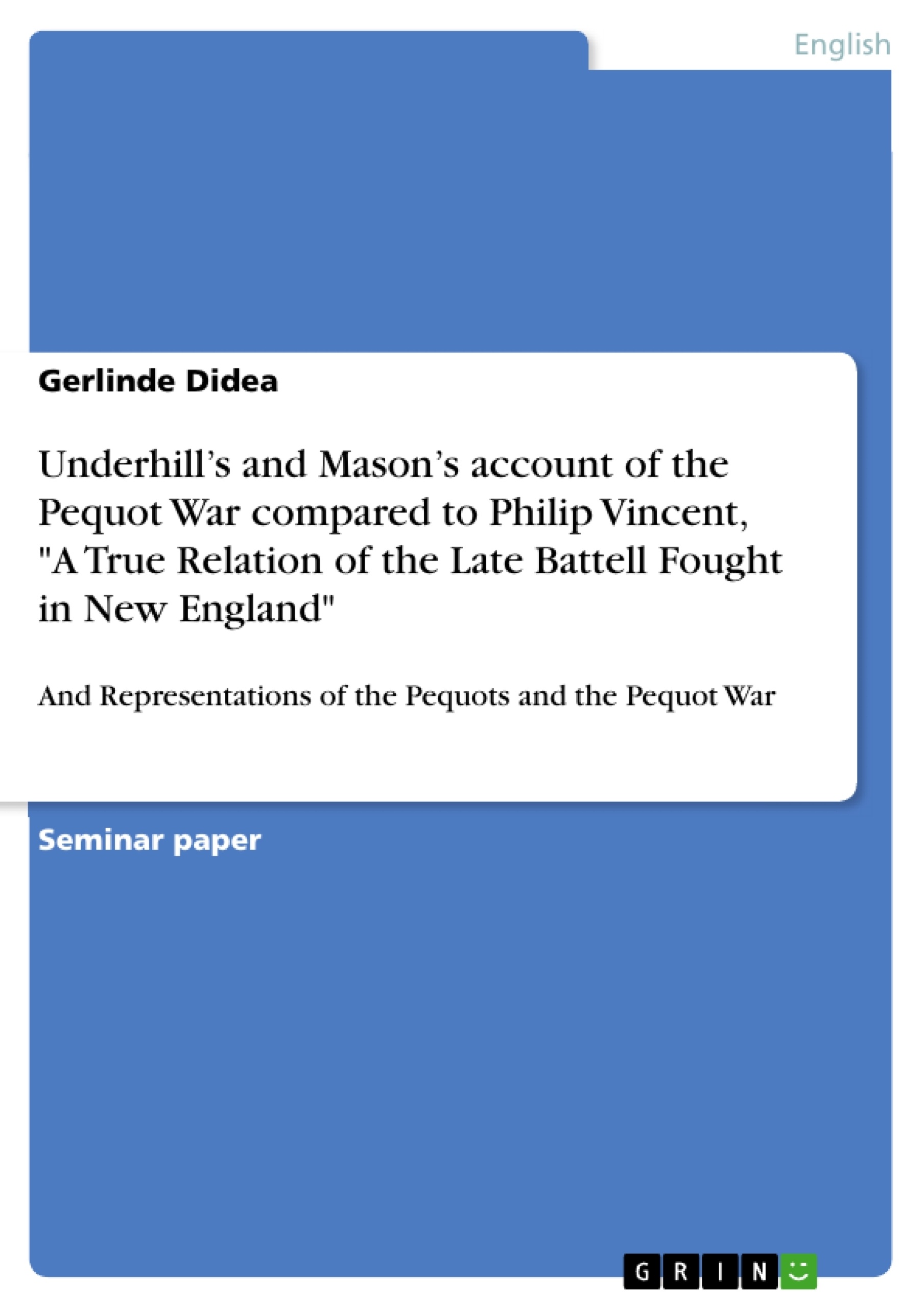In 1637, the English colonists had already had several encounters with the native inhabitants of New England. Most of them had taken place in a peaceful manner, with the exception of their encounter with the Pequots. Despite great efforts to negotiate for peaceful coexistence, the Pequots occasionally committed sudden assaults on the English colonists and thereby broke mutual agreements. The increasing Pequot aggressiveness soon exhausted the English endurance. As a consequence, the English decide to counterattack. John Mason, who commanded the Connecticut forces, focuses on the causes of war, while Captain John Underhill, commander of the Massachusetts Bay forces, relies on his theory of the successful massacre at God’s interaction. As a contemporary narrator, Philip Vincent relates on information of people who witnessed the occurrences. The applied cruelty and systematic annihilation of almost the whole Pequot tribe, of course, raise the question about justification of the reasons. Is it providence, as Underhill interprets it, that the Pequots were so cruelly attacked? Is it an act of self-preservation as Mason concludes? Or did the Pequots deserve to be massacred for their tenacious aggressiveness and insult against the English as Vincent claims? It is a fact that Mason, Underhill as well as Vincent endorse and defend the massacre from their own point of view. Since all three narratives are from the first-person point of view, the interpretations of the Pequot massacre are biased and reflect individual reasons and emotions. Religious-based racism using the Christian bible as reference; desperation and anger are the sources of the cruelty of the massacre. The strong desire for vengeance and the quest for Puritan identity cause the English describe the Pequots as God’s tool.
Table of Contents
- 1 Underhill's and Mason's account of the Pequot War compared to Philip Vincent, A True Relation of the Late Battell Fought in New England
- 1.1 Introduction
- 1.2 The Natural Aggressive People – How the Pequots are presented as being unable to cooperate and be educated
- 1.3 The Success of the Initial Attack Animates the English to the Massacre
- 1.4 Setting Fire as Climax for the English Cruelty
- 1.5 Attempts to Explain the Violence
- 1.6 Conclusion
- 2 Representations of the Pequots and the Pequot War (Periodicals)
- 2.1 Introduction
- 2.2 The Initial Steps Towards the Cultural Clash
- 2.3 Stereotypes of the Pequots Sustain the Pequot's Otherness
- 2.4 The Pequots as Threat
- 2.5 Lack of Impartial Narrations Distort the Pequot's Image
- 2.6 Influences of Descriptions
- 2.7 Conclusion
Objectives and Key Themes
This work compares accounts of the Pequot War by John Mason, John Underhill, and Philip Vincent, analyzing their depictions of the Pequots and the justifications offered for the massacre. The study examines how these narratives shape the understanding of the conflict and the involved parties.
- Contrasting perspectives on the Pequot War from different primary sources.
- Analysis of the portrayal of the Pequots in these accounts.
- Examination of the justifications used to legitimize the violence against the Pequots.
- The role of religious and cultural biases in shaping historical narratives.
- Exploring the impact of biased accounts on historical interpretations.
Chapter Summaries
Chapter 1.1 Introduction: This chapter introduces the context of the Pequot War, highlighting the conflicting accounts of John Mason, John Underhill, and Philip Vincent and their varying justifications for the massacre. It sets the stage for a comparative analysis of their narratives.
Chapter 1.2 The Natural Aggressive People: This section examines how the three authors portray the Pequots, analyzing their characterizations of Pequot behavior and the underlying biases that influence these descriptions. The chapter contrasts the views of the Pequots as inherently aggressive with a more nuanced understanding of the situation.
Chapter 1.3 The Success of the Initial Attack: This chapter analyzes the accounts of the initial attack on the Pequots, focusing on how each author portrays the event and the role of divine intervention or mere military strategy in the success of the English forces. The contrasting interpretations of the events are highlighted.
Chapter 2.1 Introduction: This chapter introduces the analysis of periodical representations of the Pequots and the war, setting the stage for exploring broader societal perceptions of the conflict.
Chapter 2.2 The Initial Steps Towards the Cultural Clash: This section delves into early interactions between the English colonists and the Pequots, laying the groundwork for understanding the escalation of tensions leading to the war.
Chapter 2.3 Stereotypes of the Pequots: This chapter discusses the perpetuation of stereotypes about the Pequots and how these stereotypes shaped perceptions and contributed to the conflict.
Keywords
Pequot War, John Mason, John Underhill, Philip Vincent, Native Americans, Colonialism, Massacre, Religious Bias, Cultural Conflict, Historical Narratives, Primary Sources, Bias in historical accounts.
- Citation du texte
- Gerlinde Didea (Auteur), 2007, Underhill’s and Mason’s account of the Pequot War compared to Philip Vincent, "A True Relation of the Late Battell Fought in New England", Munich, GRIN Verlag, https://www.grin.com/document/120726



